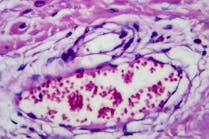A new study published by the Centers for Disease Control and Prevention (CDC), “Acute Hepatitis and Adenovirus Infection Among Children — Alabama, October 2021–February 2022” provides additional clinical and epidemiologic information from an ongoing investigation involving children in Alabama with hepatitis (inflammation of the liver) of unknown cause, according to a news release.
These findings build on previous information shared about the cluster of nine cases currently under investigation by CDC and the Alabama Department of Public Health. In the fall of 2021, clinicians at a children’s hospital in Alabama identified five patients with severe hepatitis and adenovirus infection, including some with acute liver failure. A review of hospital clinical records identified four additional cases, all of whom had liver injury and adenovirus infection. All were previously healthy, ranged in age from about 1 to 6-years-old, and had no significant underlying conditions.
Among the findings in the MMWR: two of the pediatric patients in Alabama required liver transplants, and three developed liver failure, but all have since recovered or are recovering. Prior to hospitalization, most of the children experienced vomiting and diarrhea, while some experienced upper respiratory symptoms. During hospitalization, most had yellowing eyes, yellowing skin (or jaundice), and an enlarged liver. All nine patients tested positive for adenovirus, and six tested positive for Epstein-Barr Virus but did not have antibodies, which implies an earlier, not active infection. Laboratory tests identified that some of these children had adenovirus type 41, which more commonly causes pediatric acute gastroenteritis. Additionally, some showed a history of other viruses including enterovirus/rhinovirus, metapneumovirus, respiratory syntactical virus, and human coronavirus OC43.
At this time, we believe adenovirus may be the cause for these reported cases, but other potential environmental and situational factors are still being investigated. Adenovirus type 41 is not usually known as a cause of hepatitis in otherwise healthy children, and no known epidemiological link or common exposures among these children has been found. Some causes have already been ruled out, including:
- hepatitis viruses A, B, and C
- SARS-CoV-2 infection
- autoimmune hepatitis
- Wilson disease
It’s important to note that this report is specific to the Alabama investigation, and CDC does not have an update at this time on any other suspected cases in the U.S. CDC is taking every potential reported case seriously and working vigilantly with state and local public health officials and clinicians to identify and investigate other potential cases. On April 21, CDC issued a nationwide Health Alert Network (HAN) Advisory asking all physicians to be on the lookout for symptoms and to report any suspected cases of hepatitis of unknown origin to their local and state health departments. CDC is working with commercial and state public health laboratories to provide guidance on how to submit testing.
CDC is also aware of an increase in cases of pediatric hepatitis without a known cause recently reported in Europe and has been in contact with our European counterparts to understand what they are learning. Adenovirus has been confirmed in several of the European cases, but not all. Investigators are ruling out other possible causes and identifying other possible contributing factors. As we learn more, we will share additional information and updates.





